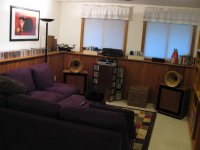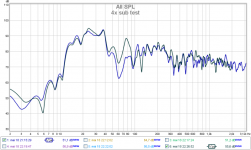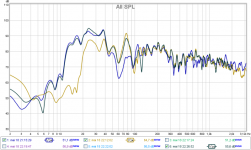They don't have to be although having one or two against a corner/wall might have its advantages as you'll probably find it easier to locate more pressure antinodes there. As you'll need to do some experimenting you may want this freedom of movement. Is it possible to place at least one in a corner?
On the other hand, if it doesn't work out, you can always add more.
On the other hand, if it doesn't work out, you can always add more.
Here are my other subs. The cabs were built in 1955 (my birth year) and spent their whole life in a church with Stromberg Calson drivers in them. The SCs were shot but I kept the cabs just cause I liked them. They are sealed with 1.5 cu ft internal volume and made with 1.5" plywood. They now have a Bash 300 plate amp in each one driveing a 12" Martin Logan D12Q2M5 subwoofer and are flat to 28hz.
As you can see they can fit tight into a corner. So, in the new room I will start out with each one in the corners behind my main speakers.


As you can see they can fit tight into a corner. So, in the new room I will start out with each one in the corners behind my main speakers.


Last edited:
Do all the subs HAVE to be aganst a wall. My wife wants me to have 1" glass tops cut for these little boxes and use them as end tables which will put them a number of feet away from the walls.
I cringe whenever I learn of any bit of radiation resistance given up without a fight or good compelling reasons*. Thin air versus heavy drivers (even ESLs).... that's the great battle in propelling clean sound into the air.
*OK, granted, one of my subs is mid-wall.
Not sure I understand B, are you saying that they should all be in corners???
Yes, in the absence of compelling reasons otherwise. As I indicated, in the interest of mix-and-match multiple subs, I departed from an all-corner approach. On the other hand, a giant OB like mine is really making its own environment.
And with more than 40 years experience seeking good corners for my Klipschorn, I can say it is lucky to find one good corner for a Klipschorn or more than 2 for anything else.
Few design parameters are as determinedly and unalloyed good as radiation resistance.
I did the same with my SpeakerLab Ks. I finally got into a house with a dedicated listening room with two solid corners.
When a sub is put into a corner, does the whole freq range get boosted or just certain freqs?
I've always had subs but never got serious about placement. I don't know the terminology you use, but I think I understand.
We are moving into a smaller house and I am building a smaller system. I had Edgarhorns with JBL 2441 CDs and the big Heil AMTs next to them. Both those were sitting on the JBL Scoops and they went down low enough not to worry about subs too much.
I still have the Edgarhorns and Heils, but I am putting them on Frazier Dixilander bass bins and then start their roll off at 90hz so the subs now become much more important.
Here is a pic of a friend of mine's set up like what I am trying to do.
When a sub is put into a corner, does the whole freq range get boosted or just certain freqs?
I've always had subs but never got serious about placement. I don't know the terminology you use, but I think I understand.
We are moving into a smaller house and I am building a smaller system. I had Edgarhorns with JBL 2441 CDs and the big Heil AMTs next to them. Both those were sitting on the JBL Scoops and they went down low enough not to worry about subs too much.
I still have the Edgarhorns and Heils, but I am putting them on Frazier Dixilander bass bins and then start their roll off at 90hz so the subs now become much more important.
Here is a pic of a friend of mine's set up like what I am trying to do.
Attachments
Last edited:
Hi djn,
From the link in Post #5:
"Subwoofer setup after Earl Geddes (GedLee LLC)
The multisub setup described on this page has two big advantages over other methods: only three subs are needed and you don't need to put the subwoofers at specified locations. Nonetheless there are some basic rules that have proven to yield best results:
Put one sub in a corner close to the mains. The second sub is a lot more flexible as to its location, but it should not be in a corner. Side wall or back wall, near the midpoint is a good idea. Put the third sub wherever you can that is not too close to the other two. It's a good idea to get one of them off of the floor."
If you read through the thread you'll find additional information on placement, and number of subs. After the initial corner-loaded sub you have a great deal of placement flexibility, end tables may be just fine. It comes down to the calibration procedure.
Could be your wife knows the best spot for the subs after all.
Regards,
From the link in Post #5:
"Subwoofer setup after Earl Geddes (GedLee LLC)
The multisub setup described on this page has two big advantages over other methods: only three subs are needed and you don't need to put the subwoofers at specified locations. Nonetheless there are some basic rules that have proven to yield best results:
Put one sub in a corner close to the mains. The second sub is a lot more flexible as to its location, but it should not be in a corner. Side wall or back wall, near the midpoint is a good idea. Put the third sub wherever you can that is not too close to the other two. It's a good idea to get one of them off of the floor."
If you read through the thread you'll find additional information on placement, and number of subs. After the initial corner-loaded sub you have a great deal of placement flexibility, end tables may be just fine. It comes down to the calibration procedure.
Could be your wife knows the best spot for the subs after all.
Regards,
Just a word of caution on those PE/Dayton plate amps. I bought a Daton 250 wt plate amp and it hums and buzzes like a huge pissed off bumble bee. I know, this is a lame post because I don’t have the model number, but I bought it to play in my system up in my cabin. I got it at home, took it to the mountains a few weeks later where it is now, installed it in the speaker box, hooked it up and it hummed so bad that I couldn’t use it for music. Dayton knew about the problem because they enclosed an instruction sheet warning about it. I did everything the sheet suggested, switched from speaker wire in to RCA plugs, reversed phase, AC to a different outlet, ground wire to the amp, ground the amp and all the sources, even grounded to the outside copper ground stake, nothing. So much time went by that I couldn’t return it. It’s OK for loud movies, but for music, anything short of loud rock is out.
The auto on/off sensor does not work consistently, but no problem there, with all that noise, I sure don’t forget to turn it off before I go to bed.
I would suggest you talk to a tech guy at PE about returns/problems/complaints before you purchase a Dayton plate amp.
Don’t get me wrong, I think PE is great and I’ve bought a lot of good stuff from them over the years, but this plate amp is not one of them.
Good luck, Dolf.
The auto on/off sensor does not work consistently, but no problem there, with all that noise, I sure don’t forget to turn it off before I go to bed.
I would suggest you talk to a tech guy at PE about returns/problems/complaints before you purchase a Dayton plate amp.
Don’t get me wrong, I think PE is great and I’ve bought a lot of good stuff from them over the years, but this plate amp is not one of them.
Good luck, Dolf.
I did the same with my SpeakerLab Ks. I finally got into a house with a dedicated listening room with two solid corners.
When a sub is put into a corner, does the whole freq range get boosted or just certain freqs?
I've always had subs but never got serious about placement. I don't know the terminology you use, but I think I understand.
We are moving into a smaller house and I am building a smaller system. I had Edgarhorns with JBL 2441 CDs and the big Heil AMTs next to them. Both those were sitting on the JBL Scoops and they went down low enough not to worry about subs too much.
snip
I see that tb46 has replied with what might be called a "doctrinaire" formula from the Gospel of Geddes. After reading Toole's exhausting discussion of multiple subs (another place where he and Geddes differ??), my impression is that many kinds of mix-and-match solutions work well and it really depends on which room or speaker deficiencies you are addressing.
Radiation resistance, if I recall Olson, becomes a factor when driver diameter is small compared to sound wave-length. So I think it comes home to roost below 250 Hz. I hope better informed people will correct me since I can be all wrong on that. But the idiocy of shaking large masses of cardboard in thin air to generate sound is true at all frequencies: you want the resistance of the air to be as relatively important as possible, not the mass of the driver.
It is widely agreed that balance of treble and bass (400,000 Rule) is important. Changes to either end need to be compensated by changes to the other. Rather easy today to create a little super-sub-woofer somewhere in the room to supplement very low bass, even if you are leaving behind a super woofer when you move. I have downsizing moving ahead of me too - at least it is some long time before I get to the headphone listening stage when in a nursing home.
Last edited:
Hi djn,
From the link in Post #5:
"Subwoofer setup after Earl Geddes (GedLee LLC)
The multisub setup described on this page has two big advantages over other methods: only three subs are needed and you don't need to put the subwoofers at specified locations. Nonetheless there are some basic rules that have proven to yield best results:
Put one sub in a corner close to the mains. The second sub is a lot more flexible as to its location, but it should not be in a corner. Side wall or back wall, near the midpoint is a good idea. Put the third sub wherever you can that is not too close to the other two. It's a good idea to get one of them off of the floor."
If you read through the thread you'll find additional information on placement, and number of subs. After the initial corner-loaded sub you have a great deal of placement flexibility, end tables may be just fine. It comes down to the calibration procedure.
Could be your wife knows the best spot for the subs after all.
Regards,
She has been right before. In the new room I do have two corners on the wall where the mains will go, so I can put one or both into the corners.
Just a word of caution on those PE/Dayton plate amps. I bought a Daton 250 wt plate amp and it hums and buzzes like a huge pissed off bumble bee. I know, this is a lame post because I don’t have the model number, but I bought it to play in my system up in my cabin. I got it at home, took it to the mountains a few weeks later where it is now, installed it in the speaker box, hooked it up and it hummed so bad that I couldn’t use it for music. Dayton knew about the problem because they enclosed an instruction sheet warning about it. I did everything the sheet suggested, switched from speaker wire in to RCA plugs, reversed phase, AC to a different outlet, ground wire to the amp, ground the amp and all the sources, even grounded to the outside copper ground stake, nothing. So much time went by that I couldn’t return it. It’s OK for loud movies, but for music, anything short of loud rock is out.
The auto on/off sensor does not work consistently, but no problem there, with all that noise, I sure don’t forget to turn it off before I go to bed.
I would suggest you talk to a tech guy at PE about returns/problems/complaints before you purchase a Dayton plate amp.
Don’t get me wrong, I think PE is great and I’ve bought a lot of good stuff from them over the years, but this plate amp is not one of them.
Good luck, Dolf.
The BASH 300 amps are dead quiet and never heat up. The other amps are bottom of the barrel but have not given me problems yet. I got them from a friend so I have no recouse but to toss them if they give out.
I see that tb46 has replied with what might be called a "doctrinaire" formula from the Gospel of Geddes. After reading Toole's exhausting discussion of multiple subs (another place where he and Geddes differ??), my impression is that many kinds of mix-and-match solutions work well and it really depends on which room or speaker deficiencies you are addressing.
Radiation resistance, if I recall Olson, becomes a factor when driver diameter is small compared to sound wave-length. So I think it comes home to roost below 250 Hz. I hope better informed people will correct me since I can be all wrong on that. But the idiocy of shaking large masses of cardboard in thin air to generate sound is true at all frequencies: you want the resistance of the air to be as relatively important as possible, not the mass of the driver.
It is widely agreed that balance of treble and bass (400,000 Rule) is important. Changes to either end need to be compensated by changes to the other. Rather easy today to create a little super-sub-woofer somewhere in the room to supplement very low bass, even if you are leaving behind a super woofer when you move. I have downsizing moving ahead of me too - at least it is some long time before I get to the headphone listening stage when in a nursing home.
Behind one wall of the new space is a laundry room and behind another wall is a 4" tall storage space as big as half the house. We were over there last night will a friend and he thinks IBs on each wall would work well too. That would be 6 subs in a 20 x 20 room. A little over kill if you ask me.
hi to everyone!
perhaps it's a silly question but how can I connect multiple small subs to one preamp line out socket? I am talking about 8-10 subs - how can it be done? Can I just use multiple Y-splitters without risking damage of my preamp?
regards!
graaf
You could use a series resistor in line with the pre-out, then parallel all sub inputs, if you want.
perhaps it's a silly question but how can I connect multiple small subs to one preamp line out socket? I am talking about 8-10 subs - how can it be done? Can I just use multiple Y-splitters without risking damage of my preamp?
If your preamp has a cap or (less common) transformer coupled output, you can't damage it even with the output shorted. But you have to remember that your input impedance for the subs will be the impedance of all 10 in parallel. Say the subs each have an input impedance of 20k, the combined impedance will be 2k. Likewise the input capacitance will be the sum of all 10. Unless your preamp has an unusually low output impedance, you will see increased distortion. If your preamp doesn't have a separate buffered output, you will need a buffer. An op amp designed for this application is a simple way to go.
Sheldon
How does it perform - a simple test
Well, how does the Multiple Sub approach perform?
I measured to verify what can relatively easily be achieved by using 4 small subs located using a simple and fast method.
The blue line is a set-up with 2 smaller subwoofers located in the front, close to the mains.
The black line is where I added two Even Smaller subs, located to try fill in the 60Hz null.
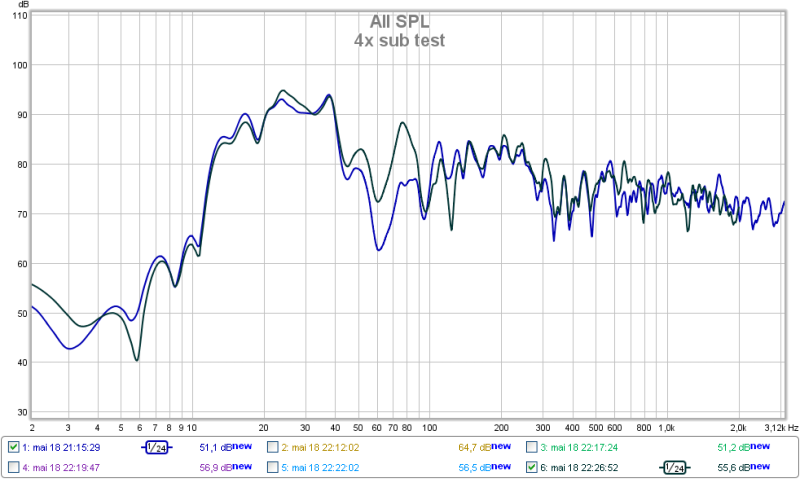
As you can see, there is a significant improvement, even though the response is yet far from flat.
The brown line is with 2 Even Smaller subs only.
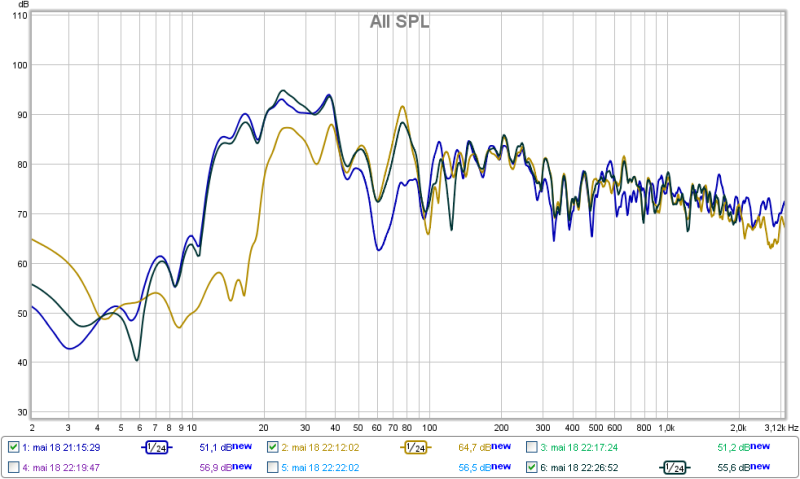
I listened to this set-up only briefly now, but the improved preformance in the mid bass especially is very noticeable, as bass drums now has much improved attack, and the bass sounds more balanced.
Listening impressions will however always be very subjective, so you should not rely to much on what I think I am hearing - trust the measurements instead.
Location Method for Additional Even Smaller Subs:
I placed one sub in the LP, 60Hz sine on, real-time spectrum anayser, and then took a trip around the room with the mic in my hand, searching for spots where the 60Hz was strong.
You could do just as good using your ears, as there is a clearly audible difference between the bad and the good locations.
This way I found that the front left corner and the rear left corner were good locations with spare room to accomodate an even smaller sub.
Further improvements:
Obviously one could try to improve the room by adding bass absorbers and resonators, you can also see from the measurements that then additional subs did little to remove the peaks and the dips - they only lifted the weak area between 50-100Hz.
Also I think there may be potential in having dedicated DSPs on each sub.
Here I would first remove everything below 40Hz from the Even Smaller.., that could make the response flatter, and it would gain headroom as those too small subs would be relieved.
Hmm.. may be I should try this some day, the DSP is readily available..
Well, how does the Multiple Sub approach perform?
I measured to verify what can relatively easily be achieved by using 4 small subs located using a simple and fast method.
The blue line is a set-up with 2 smaller subwoofers located in the front, close to the mains.
The black line is where I added two Even Smaller subs, located to try fill in the 60Hz null.
As you can see, there is a significant improvement, even though the response is yet far from flat.
The brown line is with 2 Even Smaller subs only.
I listened to this set-up only briefly now, but the improved preformance in the mid bass especially is very noticeable, as bass drums now has much improved attack, and the bass sounds more balanced.
Listening impressions will however always be very subjective, so you should not rely to much on what I think I am hearing - trust the measurements instead.
Location Method for Additional Even Smaller Subs:
I placed one sub in the LP, 60Hz sine on, real-time spectrum anayser, and then took a trip around the room with the mic in my hand, searching for spots where the 60Hz was strong.
You could do just as good using your ears, as there is a clearly audible difference between the bad and the good locations.
This way I found that the front left corner and the rear left corner were good locations with spare room to accomodate an even smaller sub.
Further improvements:
Obviously one could try to improve the room by adding bass absorbers and resonators, you can also see from the measurements that then additional subs did little to remove the peaks and the dips - they only lifted the weak area between 50-100Hz.
Also I think there may be potential in having dedicated DSPs on each sub.
Here I would first remove everything below 40Hz from the Even Smaller.., that could make the response flatter, and it would gain headroom as those too small subs would be relieved.
Hmm.. may be I should try this some day, the DSP is readily available..
Attachments
Some more data in favor of Geddes' approach. (5-point spatially-averaged measurements)
Three subs' individual raw responses, with mains (120Hz crossover), but no EQ:
S1 (front-left corner)
(The notch at the top of the graph is from the mains' floor bounce, which from other measurements is centered at about 230Hz. You'll see it in the rest of the graphs, too.)
S2 (~25% down the right wall)
S3 (~70% down the left wall, practically nearfield)
Of the three, the nearfield-ish S3 by itself has the smoothest response, followed by corner-loaded S1 and then S2. But it's still pretty bad, thanks to the ~80Hz null. And you lose A LOT of low end, as you can see by comparing S2 and S3. (They are identical subwoofers, just placed differently.) S2, which is closer to a room corner, has a significantly lower corner.
So... any one of those alone...no thanks! Even with massive EQ. But add them together using Geddes' method, and:
Summed response S1+S2+S3, after just optimizing levels and delays on the miniDSP, prior to application of any EQ
I think most people could live with that, honestly. It sounded really good as it stood. BUT:
Summed response S1+S2+S3, after Audyssey calibration (MultEQ XT on, DynamicEQ off) and three bands of fairly mild EQ cuts
Icing on the cake!
Three subs' individual raw responses, with mains (120Hz crossover), but no EQ:
S1 (front-left corner)
An externally hosted image should be here but it was not working when we last tested it.
(The notch at the top of the graph is from the mains' floor bounce, which from other measurements is centered at about 230Hz. You'll see it in the rest of the graphs, too.)
S2 (~25% down the right wall)
An externally hosted image should be here but it was not working when we last tested it.
S3 (~70% down the left wall, practically nearfield)
An externally hosted image should be here but it was not working when we last tested it.
Of the three, the nearfield-ish S3 by itself has the smoothest response, followed by corner-loaded S1 and then S2. But it's still pretty bad, thanks to the ~80Hz null. And you lose A LOT of low end, as you can see by comparing S2 and S3. (They are identical subwoofers, just placed differently.) S2, which is closer to a room corner, has a significantly lower corner.
So... any one of those alone...no thanks! Even with massive EQ. But add them together using Geddes' method, and:
Summed response S1+S2+S3, after just optimizing levels and delays on the miniDSP, prior to application of any EQ
An externally hosted image should be here but it was not working when we last tested it.
I think most people could live with that, honestly. It sounded really good as it stood. BUT:
Summed response S1+S2+S3, after Audyssey calibration (MultEQ XT on, DynamicEQ off) and three bands of fairly mild EQ cuts
An externally hosted image should be here but it was not working when we last tested it.
Icing on the cake!
Last edited:
Thanks. Any distance at the listening pos. less than 1M?
No. The closest is S3, which is 2.5m away, give or take a bit. S1 and S2 are significantly farther way.
- Home
- Loudspeakers
- Subwoofers
- Multiple Small Subs - Geddes Approach
